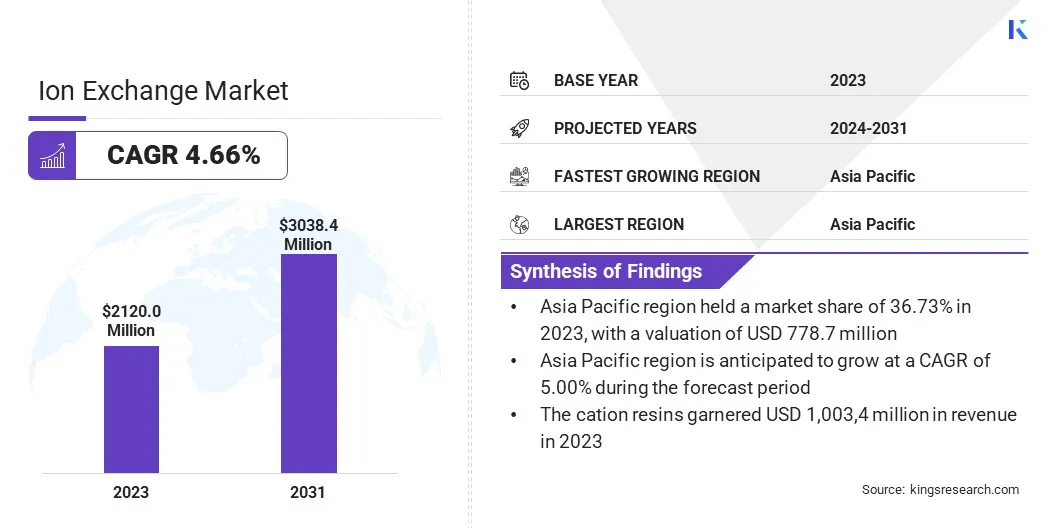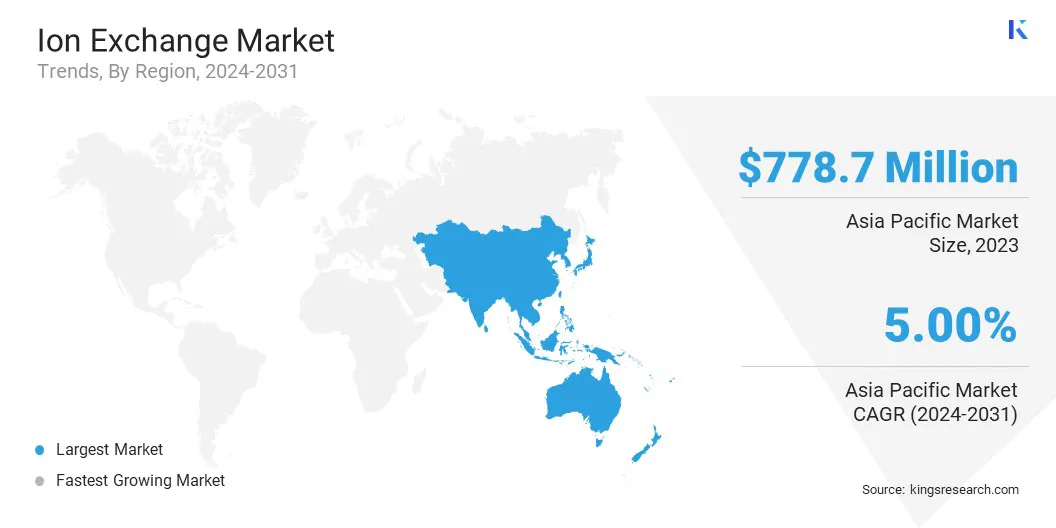Market Definition
The ion exchange resins market involves the production, distribution, and application of synthetic resins designed to facilitate ion exchange processes. These resins, typically made from cross-linked polymers, are engineered to remove undesirable ions from liquids and replace them with beneficial ones, making them essential in various industrial and commercial applications.
Ion Exchange Resins Market Overview
The global ion exchange resins market size was valued at USD 2,120.0 million in 2023 and is projected to grow from USD 2,208.6 million in 2024 to USD 3,038.4 million by 2031, exhibiting a CAGR of 4.66% during the forecast period.
This growth is attributed to the increasing demand for water purification solutions, strict regulatory compliance across industries, and technological advancements enhancing resin efficiency and sustainability. Rising industrialization in emerging economies, particularly in China and India, further supports the market expansion.
Major companies operating in the global ion exchange resins industry are LANXESS, DOSHION POLYSCIENCE PVT. LTD., Cytiva, Samyang Corporation, JACOBI RESINS, Aldex Chemical Company, Ltd., Sunresin New Materials Co.Ltd., Thermax Limited, IEI, Otto Chemie Pvt. Ltd., DuPont de Nemours, Inc., Taiyuan Lanlang Technology Industrial Corp., OVIVO, Ecolab, and Mitsubishi Chemical Group Corporation.
Sustainability trends, including the development of bio-based and recyclable ion exchange resins, are gaining traction as industries shift to eco-friendly solutions. Increasing investments in desalination projects and the circular economy further support the market growth.

Key Highlights:
- The global ion exchange resins market size was valued at USD 2,120.0 million in 2023.
- The market is projected to grow at a CAGR of 4.66% from 2024 to 2031.
- Asia Pacific held a market share of 36.73% in 2023, with a valuation of USD 778.7 million.
- The cation resins segment garnered USD 1,003.4 million in revenue in 2023.
- The power generation segment is expected to reach USD 1,096.5 million by 2031.
- The market in North America is anticipated to grow at a CAGR of 4.82% during the forecast period.
Market Driver
"Increasing Demand for Advanced Water Treatment Solutions"
The ion exchange resins market is registering substantial growth, due to the increasing demand for advanced water treatment solutions across industrial, municipal, and residential sectors. Industries such as power generation, pharmaceuticals, and food & beverage rely on ion exchange resins for demineralization, softening, and contaminant removal.
Rapid industrialization, urbanization, and population growth have placed immense pressure on global water resources, raising concerns over water scarcity, contamination, and environmental sustainability. As a result, industries and governments are investing heavily in efficient water purification technologies to ensure safe and clean water supply.
Market Challenge
"Development of Biodegradable and Recyclable Ion Exchange Resins"
A significant challenge facing the ion exchange resins market is the environmental impact associated with resin disposal and regeneration processes. Traditional ion exchange resins, primarily made from synthetic polymers derived from petroleum-based sources, present challenges in degradation and end-of-life disposal.
Improper disposal can contribute to microplastic pollution and chemical waste accumulation, raising environmental concerns and regulatory scrutiny. The industry is shifting to the development of biodegradable and recyclable ion exchange resins that minimize environmental impact while maintaining efficiency.
Researchers and manufacturers are exploring bio-based resins made from renewable materials that provide comparable performance to conventional resins while being more environmentally friendly.
Market Trend
"Growing Emphasis on Sustainable and Eco-friendly Ion Exchange Resins"
The ion exchange resins market is shifting toward sustainable and eco-friendly solutions, due to increasing regulatory pressure, environmental concerns, and the rising demand for greener alternatives.
Conventional ion exchange resins, primarily derived from petroleum-based polymers, pose challenges related to disposal, degradation, and microplastic pollution. Manufacturers are developing bio-based and recyclable ion exchange resins, reducing reliance on fossil fuels and lowering environmental impact. Efforts are also being made to enhance resin durability and efficiency, minimizing regeneration frequency and operational waste.
- In April 2024, LANXESS announced its Lewatit UltraPure ion exchange resins for continuous water purification in PEM electrolysis. This innovation supports sustainable hydrogen production by ensuring high water purity, enhancing system efficiency, and enabling reliable conversion of renewable electricity into hydrogen for a cleaner energy future.
Ion Exchange Resins Market Report Snapshot
|
Segmentation
|
Details
|
|
By Type
|
Cation Resins, Anion Resins, Others
|
|
By Application
|
Water Treatment, Power Generation, Chemicals and Petrochemicals, Pharmaceuticals, Others
|
|
By Region
|
North America: U.S., Canada, Mexico
|
|
Europe: France, UK, Spain, Germany, Italy, Russia, Rest of Europe
|
|
Asia Pacific: China, Japan, India, Australia, ASEAN, South Korea, Rest of Asia Pacific
|
|
Middle East & Africa: Turkey, UAE, Saudi Arabia, South Africa, Rest of Middle East & Africa
|
|
South America: Brazil, Argentina, Rest of South America
|
Market Segmentation:
- By Type (Cation Resins, Anion Resins, Others): The cation resins segment earned USD 1,003.4 million in 2023, due to their widespread use in water softening, demineralization, and heavy metal removal across power generation, chemicals, and pharmaceuticals industries.
- By Application (Water Treatment, Power Generation, Chemicals and Petrochemicals, Pharmaceuticals, and Others): The power generation segment held 36.54% share of the market in 2023, due to the growing need for ultrapure water in boiler feed water treatment, condensate polishing, and nuclear reactor cooling systems.
Ion Exchange Resins Market Regional Analysis
Based on region, the global market has been classified into North America, Europe, Asia Pacific, Middle East & Africa, and Latin America.

Asia Pacific accounted for a ion exchange resins market share of around 36.73% in 2023, with a valuation of USD 778.7 million. This is attributed to the rapid industrialization, expanding water treatment infrastructure, and rising demand from key industries such as power generation, pharmaceuticals, and chemicals.
Countries such as China and India are implementing strict wastewater treatment policies, encouraging industries to adopt advanced water purification technologies. Additionally, increasing environmental regulations and government initiatives for clean water solutions are boosting the market in the region.
- In May 2024, Veolia Water Technologies inaugurated its first ion exchange resin regeneration plant in China, highlighting the market shift to sustainability. This facility supports circular economy initiatives by regenerating used resins, reducing waste, and minimizing chemical usage, meeting the growing industrial demand for eco-friendly water treatment solutions.
The ion exchange resins industry in North America is poised to grow at a significant CAGR of 4.82% over the forecast period, supported by strong regulatory frameworks, technological advancements, and the presence of leading manufacturers.
The U.S. and Canada are investing heavily in water and wastewater treatment facilities, due to increasing concerns over water pollution and contamination. The region’s robust pharmaceutical, nuclear power, and chemical industries are also driving the demand for high-performance ion exchange resins.
Additionally, the growing adoption of bio-based and sustainable resins is shaping market trends, as companies focus on reducing environmental impact and complying with Environmental Protection Agency (EPA) standards.
Regulatory Frameworks
- In the U.S., the EPA regulates the market for water treatment applications, ensuring compliance with environmental and safety standards. The EPA oversees resin usage in drinking water and wastewater treatment to prevent contamination and promote sustainable water management practices.
- In India, the market is regulated by the Bureau of Indian Standards (BIS), which sets quality benchmarks for water treatment resins, and the Central Pollution Control Board (CPCB), which enforces environmental regulations on manufacturing, usage, and disposal to ensure sustainability and compliance.
Competitive Landscape:
The global ion exchange resins market is characterized by a large number of participants, including established corporations and rising organizations. Leading players focus on technological advancements, sustainability initiatives, and capacity expansions to meet the growing demand across industries such as water treatment, power generation, pharmaceuticals, and chemicals.
Major companies in the market engage in mergers and acquisitions, joint ventures, and R&D investments to strengthen their portfolios and expand their global footprint. The industry is also registering a shift toward eco-friendly and bio-based resins, prompting key players to develop sustainable solutions in response to stringent environmental regulations.
Additionally, regional and local manufacturers are competing by offering cost-effective alternatives and specialized products tailored to industry-specific needs. Companies continue to focus on quality, efficiency, and regulatory compliance as market demand grows, driving innovation and further intensifying competition in the market.
List of Key Companies in Ion Exchange Resins Market:
- LANXESS
- DOSHION POLYSCIENCE PVT. LTD.
- Cytiva
- Samyang Corporation
- JACOBI RESINS
- Aldex Chemical Company, Ltd.
- Sunresin New Materials Co.Ltd.
- Thermax Limited
- IEI
- Otto Chemie Pvt. Ltd.
- DuPont de Nemours, Inc.
- Taiyuan Lanlang Technology Industrial Corp.
- OVIVO
- Ecolab
- Mitsubishi Chemical Group Corporation
Recent Developments (New Product Launch)
- In September 2023, DuPont announced the launch of AmberLite P2X110 Ion Exchange Resin, its first product dedicated to green hydrogen production. Designed for the unique chemistry of electrolyzer loops, this resin enhances hydrogen generation from water, reinforcing DuPont’s commitment to sustainable energy solutions in the market.


